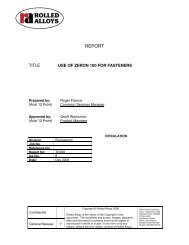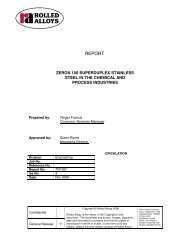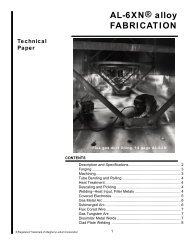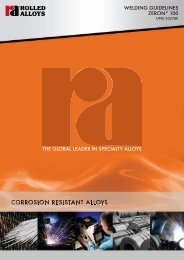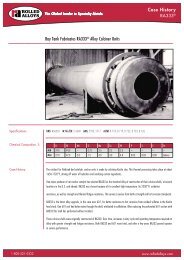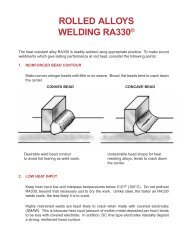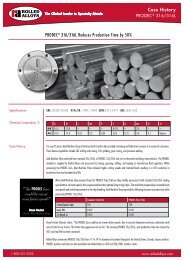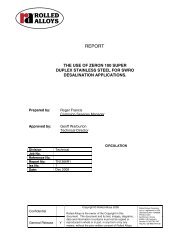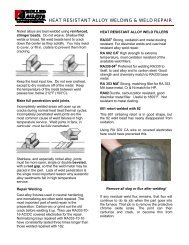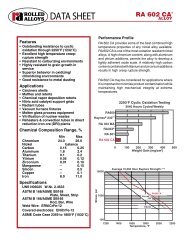General Product Safety Data Sheet - Rolled Alloys
General Product Safety Data Sheet - Rolled Alloys
General Product Safety Data Sheet - Rolled Alloys
You also want an ePaper? Increase the reach of your titles
YUMPU automatically turns print PDFs into web optimized ePapers that Google loves.
fumes.<br />
Section XI – TOXICOLOGICAL INFORMATION<br />
Nickel and cobalt are classified as Category 3 carcinogens. The exposure route<br />
of concern is inhalation.<br />
As shipped, these complex alloys in massive form have no known toxicological<br />
properties other than causing allergic reactions in individuals sensitive to the<br />
metal(s) contained in the alloys. However, dust from flux or user-generated dusts<br />
and fumes may on contact with the skin or eyes produce mechanical irritation.<br />
Chronic exposures coupled with sweat could cause dermatitis (skin) or<br />
conjunctivitis (eyes).<br />
Excessive inhalation of dust or user-generated fumes from welding or metal<br />
spraying may, depending on the specific features of the process used, pose a<br />
long-term health hazard. The International Agency for Research on Cancer<br />
(IARC) has concluded that welding fumes are possibly carcinogenic to humans.<br />
The ingredients of fumes and gases generated in welding, metals spraying and<br />
grinding will depend on the base metal and the details of the specific process<br />
being used. Ingredients may include metals, metal oxides, chromates, fluorides,<br />
carbon monoxide, ozone, and oxides of nitrogen.<br />
DELAYED (SUBCHRONIC AND CHRONIC) EFFECTS:<br />
Chromium - The International Agency for Research on Cancer (IARC) considers<br />
hexavalent chromium to be a carcinogen (lung, nasal) but does not have<br />
adequate evidence for chromium metal and trivalent chromium. Fumes have<br />
been associated with lung fibrosis.<br />
Iron - Prolonged inhalation of iron oxide fumes can lead to siderosis, which<br />
presents as a benign pneumoconiosis.<br />
Molybdenum - Repeated inhalation of fumes has caused kidney damage,<br />
respiratory irritation and liver damage in animals.<br />
Nickel - Nickel metal is “reasonably anticipated to be a human carcinogen”<br />
(National Toxicology Program’s 10th Report). IARC states that nickel metal is<br />
possibly carcinogenic to humans. Epidemiological studies of workers exposed to<br />
nickel powders, dusts and fumes in the nickel alloy and stainless steel producing<br />
industries do not indicate a significant respiratory cancer hazard. Inhalation of<br />
nickel powder produced malignant tumors in rodent studies. Single intratracheal<br />
installations of nickel powder at levels close to the LD50 have caused<br />
malignancies in hamsters. Nickel can cause skin sensitization in susceptible<br />
individuals through prolonged contact with skin.<br />
Section XII – ECOLOGICAL INFORMATION




